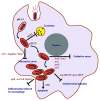Salmonella enterica serovars Typhimurium and Typhi as model organisms: revealing paradigm of host-pathogen interactions
- PMID: 22722237
- PMCID: PMC3478240
- DOI: 10.4161/viru.21087
Salmonella enterica serovars Typhimurium and Typhi as model organisms: revealing paradigm of host-pathogen interactions
Abstract
The lifestyle of intracellular pathogens has always questioned the skill of a microbiologist in the context of finding the permanent cure to the diseases caused by them. The best tool utilized by these pathogens is their ability to reside inside the host cell, which enables them to easily bypass the humoral immunity of the host, such as the complement system. They further escape from the intracellular immunity, such as lysosome and inflammasome, mostly by forming a protective vacuole-bound niche derived from the host itself. Some of the most dreadful diseases are caused by these vacuolar pathogens, for example, tuberculosis by Mycobacterium or typhoid fever by Salmonella. To deal with such successful pathogens therapeutically, the knowledge of a host-pathogen interaction system becomes primarily essential, which further depends on the use of a model system. A well characterized pathogen, namely Salmonella, suits the role of a model for this purpose, which can infect a wide array of hosts causing a variety of diseases. This review focuses on various such aspects of research on Salmonella which are useful for studying the pathogenesis of other intracellular pathogens.
Figures



References
Publication types
MeSH terms
LinkOut - more resources
Full Text Sources
